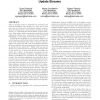533 search results - page 105 / 107 » Protocol synthesis from timed and structured specifications |
SIGMOD
2006
ACM
14 years 11 months ago
2006
ACM
The reverse k-nearest neighbor (RkNN) problem, i.e. finding all objects in a data set the k-nearest neighbors of which include a specified query object, is a generalization of the...
SIGMOD
2003
ACM
14 years 11 months ago
2003
ACM
There is growing interest in algorithms for processing and querying continuous data streams (i.e., data that is seen only once in a fixed order) with limited memory resources. In ...
CBMS
2006
IEEE
14 years 5 months ago
2006
IEEE
With the advances in medical imaging devices, large volumes of high-resolution 3D medical image data have been produced. These high-resolution 3D data are very large in size, and ...
MIE
2008
14 years 9 days ago
2008
In the United States and Europe, electronic health records (EHRs) allow information technology and decision-support to facilitate the activities of clinicians and are considered a...
CISIS
2007
IEEE
13 years 11 months ago
2007
IEEE
Problem determination in today's computing environments consumes between 30 and 70% of an organization’s IT resources and represents from one third to one half of their tot...

